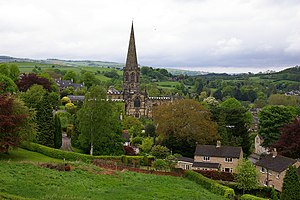
The parish with its parish church(es) is the basic territorial unit of the Church of England. The parish has its roots in the Roman Catholic Church and survived the English Reformation largely untouched. Each is within one of 42 dioceses:[1] divided between the thirty of the Canterbury and the twelve of that of York. There are around 12,500 Church of England parishes.[2] Historically, in England and Wales, the parish was the principal unit of local administration for both church and civil purposes; that changed in the 19th century when separate civil parishes were established. Many Church of England parishes still align, fully or in part, with civil parishes boundaries.
Each such ecclesiastical parish is administered by a parish priest, specifically Rector, Vicar or Perpetual curate depending on if the original set up of the rectory had become lay or disappropriated meaning its medieval rectorial property rights sold or bestowed on another body such as an abbey. This person may be assisted by curate(s) and/or deacon(s), who are also ordained and by lay clergy such as readers. High variance exists in the size of parishes, attendees and the number of christenings (baptisms), marriages, funerals and donations. Each parish is considered in the annual assessment and rebalancing of the diocese which pays the clergy's income (and indirectly by the Commissioners as regards most old endowments which are held in common). A parish priest may serve one parish or more and some are part of a team ministry. As a shorthand, the term can mean the community or the combined annual congregation.
- ^ "Church of England".
- ^ "Research and Statistics". The Church of England. Retrieved 2019-09-26.
© MMXXIII Rich X Search. We shall prevail. All rights reserved. Rich X Search
